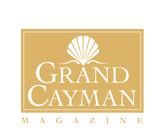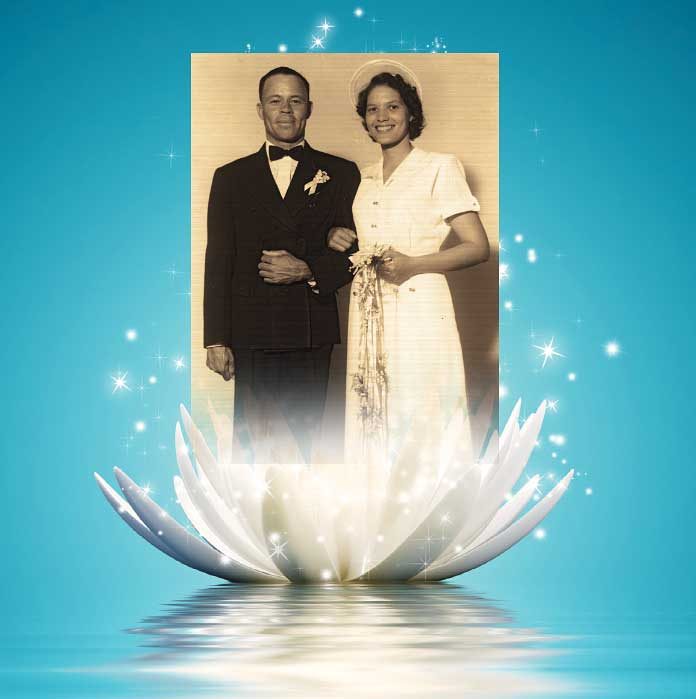What would life be without nature’s gift of flowers? Not only do they beautify and enhance our environment, many will grow in the harshest of circumstances. Certain “Flowers” are so resilient, they thrive, even multiply, when transplanted into new surroundings, just like Clarence Levi Flowers who put down roots in Grand Cayman in 1931.
Clarence left his native country of Jamaica at the tender age of 13 so he could build a better life for himself. When he first arrived on the sleepy island to begin working for the H.O. Merren family as a yard boy, he didn’t realize that he had already taken his first steps toward building a legacy far greater than anything he ever dreamed of achieving in his lifetime. Mention the name “Flowers” to anyone in Cayman and the words “blocks” and “water” spring to mind, but there’s also the Flowers One-Mile Sea Swim, which has grown into a not only a Cayman Institution but a world-renowned competitive open-sea swim that attracts international elite athletes each year, including Olympians. It seems that no matter what seed the Flowers family sows, it blooms into a successful enterprise.
The Flowers Group is a diverse family-owned group of companies run by Clarence’s three grown sons: Frank Sr., age 66 (wife Eve); Richard, age 60 (wife Sandra); and Clarence “King,” age 56 (wife Lisa). Frank Sr. and Eve have two adult children, Dara Flowers Burke, 32 (husband Daniel, daughter Alexandra), and Frank Jr., 35 (partner Samantha, daughter Sinclair).
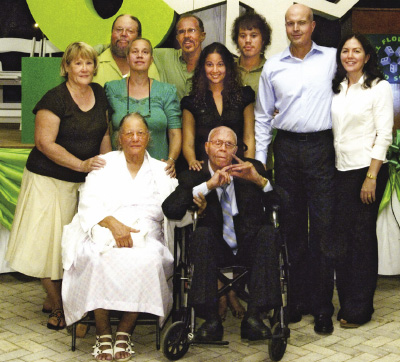
Front row: Miss Jen and Clarence.
Back row, left to right: Sandy and Richard, Eve and Frank Sr., Dara and Frank Jr., King and Lisa.
Frank Sr. is the managing director of the manufacturing components of the company, including: Flowers Block; Flowers Foam Products; Flowers Steel Stud; Eagle Transport; and FADS (Flowers Air Dispatch Services), which he runs alongside Dara, who is the director, and his son-in-law Daniel, finance manager.
Richard operates Flowers Bottled Water (including five gallons and coolers), while King runs Orchid Development, which created the George Town office park Cricket Square. Frank Jr. is a successful writer and director based in Los Angeles and although he is not part of the daily family business operations, he has demonstrated the same perseverance, hard work and integrity in his Hollywood pursuits. Earlier this year he closed a deal with Universal Studios to write the script about the early life of basketball star Lebron James and his four high school teammates which will be made into a feature film; and the 2013 independent film “Metro Manila,” which Frank Jr. co-wrote, won a Sundance Film Festival award in 2013 and was nominated for a British Academy of Film and Television Arts award in early 2014.
Family Synergy
There is a flurry of activity at the Flowers Block offices on Seymour Drive off Industrial Road. It is just five days before their annual Sea Swim charity event which takes place each year in June to coincide with the Queen’s Birthday statutory holiday. It doesn’t take long to gather that this business is, indeed, a “family affair.” Dara, who is poised to carry the company torch after her father retires, sits at her desk in the office she shares with Daniel while he busily works adjacent to her. There are papers and files stacked high and the phones ring with regularity.
Frank Sr. sits down, cup of coffee in hand. It is evident that he and Dara have a close father-and-daughter relationship to the point where they even finish each other’s sentences. Just then, Eve walks in and takes a protective seat behind Frank Sr.
The Sea Swim is not only the island’s biggest annual sporting event, but also the longest, continuously running swim meet Cayman has ever hosted. Since it started 22 years ago, the Sea Swim has grown into one of the top open-water swimming competitions in the world. Nearly 1,000 swimmers and 200 walkers are registered for the Saturday one-mile event; more than 700 spectators are expected that day, as well. With many generous sponsors, the Sea Swim is quite lucrative for participants. Prizes include $100,000 in cash and random prizes and 42 airline tickets to 22 destinations. A fun family event for all ages, it’s also so well known in international swimming circles that in 2013 they introduced a 5-K and 10-K sea swim for the Holiday Monday. Dara reports there are 26 Olympic medals between the participants this year, including American Olympic medalists Ian Crocker, Brooke Bennett and Megan Jendrick, to name a few. Cayman’s Olympian brothers Brett and Shaune Fraser are regulars, too.
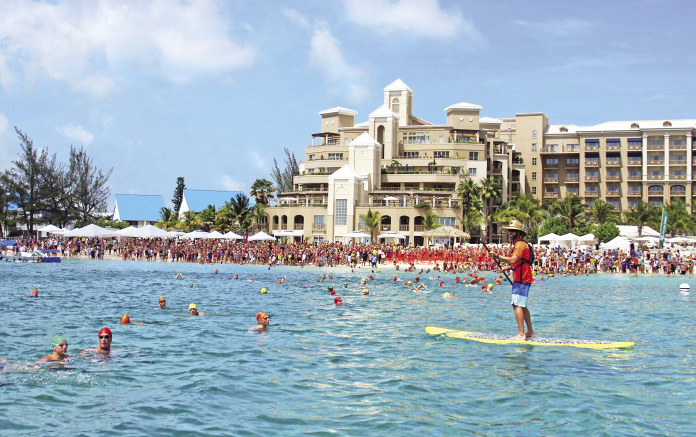
spectators to Seven Mile Beach.
It’s hard to believe that when this premier charity event started in 1992, 39-year-old Frank Sr. had only just learned how to swim. Known as “Fat Frankie” growing up, not only did he shed those pounds as an adult, but he also became a marathon runner. However, after some injuries, he decided to cross-train and pick up another sport. He began participating in a few sea swims, such as the “Cayman Airways Half-Mile” and the “Lobster Pot Mile” events. The organizers of those two races were looking for someone to take them over, which at the time attracted only two dozen or so die-hard open water swimmers. Frank took on the challenge and then amalgamated both races into one, renaming it the “Flowers One-Mile Sea Swim.” A few years in, he brought in international athletes so that local kids could have the opportunity to swim alongside the best in the world.
The charity component began after Hurricane Ivan when the island was still on its knees. Frank Sr. decided to donate the proceeds to three needy families so they could live for free for a year. With the help of donated services from various companies, they were able to cover groceries, water, phone services, and more. Blocks were also given away to repair damaged homes. He estimates they gave away over a $100,000 after Ivan.
Now they have a committee that chooses one charity each year and 100 percent of all their registration proceeds go to that charity. This year is their third year working with Feed our Future, which provides hot healthy lunches for needy school children, and although it does cost the Flowers Group money to run the event, they refuse to take any fee for administration and know that without their sponsors’ generous donations, it wouldn’t be what it is today.

Although he competes each year, Frank Sr. still doesn’t see himself as a strong swimmer. “Dara will probably beat me this year – wait, no, she can’t because she doesn’t practice – but she could if she trained harder!” (Editor’s Note: Frank Sr. actually finished in 307th place, Dara in 482nd place, and Frank Jr. placed 271st).
Asked if it has become somewhat of a burden each year to organize the event, Dara’s reply is an emphatic no. “It’s a social commitment. It’s our thing. It’s definitely a labor of love, but it’s so worth it. The charity aspect is amazing for the community but there’s also the fellowship, the fun and the family aspect – it’s a healthy, clean and cool thing to do on a Saturday in the summer. I feel like it’s our passion project now.”
Another passion project Frank Sr. and his team organized a few years ago, along with the help of sponsors Red Sail Sports and Harbour House Marina, was the “Bridging the Cayman Islands Swim 2011” in which an athlete would swim between all three islands.
It took over a year of planning and on June 6, 2011 pioneer long-distance marathon swimmer Penny Palfrey made history when she broke a world record swimming the five-mile channel from Cayman Brac to Little Cayman. This was followed a week later by her historic 67.26 mile continuous swim between Little Cayman and Grand Cayman. Penny swam for an unprecedented 40 hours, 41 minutes and 12 seconds, making it the longest unassisted ocean swim ever completed at the time. Her gratitude for Frank is immense.
“Those swims simply would not have been possible without him and the Flowers family. They organized all of the logistics: two big escort boats, two RIBS, kayakers, medical personnel and an on-water crew of over 20 people. And they raised the funds to make it all happen. Mr. Flowers was not only kind, generous and hugely enthusiastic; he also had the ability to make things happen very quickly,” says Penny.
Toughest Block on the Rock
Clarence went to war for the British Royal Navy from 1941 to 1945 and when he returned to Cayman, he took the small amount of savings he had squirreled away and bought a Bedford truck, setting the wheels in motion for his very first business at age 28, which was to transport passengers and cargo from George Town to the Eastern districts and back. Wing Commander Owen Roberts started air service to Grand Cayman in the early 1950s with seaplanes, so the landing strip at the time was the North Sound. Clarence also used his wooden boat to transfer luggage from these first seaplanes to the shore.
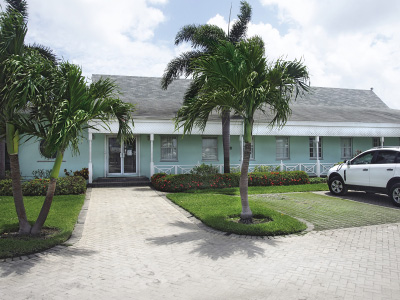
In essence, Clarence could be considered the very first bus or taxi operator in Cayman. As Frank Sr. describes it, his truck had wooden seats on one side that could be removed and a canopy on the other. Apart from cargo and passengers, he also transported thatch rope, firewood or other provisions, since these were the days before electric or gas stoves. Many of his passengers were the first tourists of Cayman heading to the East End. The journey was arduous, at times taking him two days due to the bad roads which would create flat tires, but he never quit and was never deterred. “Back then, there was nothing in Cayman. Everyone was poor and happy, but my dad always had a lot of ambition. Some people are born with drive and ambition and I guess what really pushed him to succeed was that he had a beautiful bride-to-be from South Sound, and he wanted to have a house before he got married,” says Frank Sr.
That young woman was Otto Lee Hinds (better known to all as Miss Jen). Back then it was standard to have a house before starting a family and Miss Jen waited patiently for him to make this dream come true – seven years, to be exact. This couldn’t be any old Wattle and Daub house for Miss Jen, which was the only type on the island at the time since builders in those days learned their trades in the shipyards, working with timber. It had to be termite-proof and strong enough to endure inclement weather, so he set out to make it out of concrete blocks. Clarence first saw concrete houses in Trinidad while serving as a seaman gunner in the Trinidad Royal Naval Volunteer Reserve during World War II; in Grand Cayman, the George Town post office, library and town hall were all built out of concrete.
There was one problem. Clarence couldn’t get concrete blocks in Cayman so he leased the government’s hand-operated mould and started making his blocks. By 1946, he was able to buy his first concrete block machine, which was a manual hand machine that could make up to 90 blocks per day.
Six years later in 1952, two weeks shy of his wedding to Miss Jen, the block house was complete. Situated on Shedden Road (back then, it was considered an extension of Crewe Road), his 20-foot by 30-foot passion project was ready for a family. It also happened to be the envy of all their neighbors; it was only a matter of time before the island started talking about the “Flowers block house.” Its clean lines and solid structure was impressive and soon people began asking for concrete blocks to build their own homes. By 1955, all three sons were born and C.L. Flowers & Sons Ltd. was officially in business.
Little did he know that his labor of love would catapult his company into the multi-million-dollar concrete block business it is today, but Clarence was smart enough to see an opportunity.
“What most people don’t realize is that Clarence Flowers single-handedly pioneered a standard of building homes in Cayman that made it the highest quality in the Caribbean,” says Frank Sr., adding, “One thing he never did and which we still don’t do is compete against our customers. We only manufacture the blocks.”
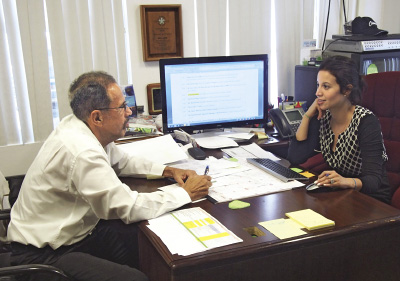
Dara says it another way: “We are not contractors, we don’t build things, with the exception of Cricket Square which was done privately through Orchid Development. We sell to the contractors so if someone wants to build a house, they would come to us and we sell the blocks direct to them or their contractor.”
Frank Sr. says his father was very principled and wanted to give everyone a level playing field. No customer was too small. “Daddy always told me, ‘Frank, you don’t have a monopoly, you have a commitment to the public as there is nowhere else for them to go so you always have to service them and keep them happy.’ We don’t take our customers for granted. Not one.”
Flowers Block has never run out of blocks in the history of the business – even during Hurricane Ivan – and it has always been their mission to have at least three months supply in their stockyard, on Clarence’s decree. According to Richard, his parents raised all three sons in the school of hard work. “We grew up knowing that family was the most important and that we should always give back to the community.” King says he learned more from his father’s behavior than his lecturing. “I learnt that if you treat people fairly and respectfully, you usually get the same in return.”
Clarence kept himself busy with other little businesses during the early 1960s. He bought a water tanker to deliver water to cisterns, and upgraded to a new block machine with the capacity to produce 2,000 blocks per day. By 1966, Clarence upgraded to a “Model 8” machine that could produce 8 blocks a minute or approximately 4,000 blocks a day. Frank Sr. began running the block plant in 1967 (which was located next to their home), after years of working there before and after school. In fact, all three boys were expected to work at the plant in the late ’60s.

Working in the family business was not just relegated to the second generation of Flowers men. As Frank Jr. puts it, “We grew up around the block factory. My dad is an extremely hard worker, especially when we were kids – he would come home covered in grease and muck. I remember going to the old factory on a school night, asleep in the back of our Oldsmobile station wagon to bring food for him and the men because the plant had broken down. In the summers, I worked in the various businesses but the bottled water was my favorite because they were the first of our companies to have a computer. I also did a summer at the airport on the ramp, which gave me a whole other level of respect for the intense labor that goes into baggage handling and security.”
By 1972, Flowers Block was like a well-oiled machine. Perhaps, it was a testament to Clarence’s fairness and equality, but no competitor successfully encroached on the Flowers’ niche market, which still holds true today. It was time to divert his attentions to his other business interest – water.
Troubled Waters No More
Frank Sr. feels that it was this next business that helped pioneer tourism in the Cayman Islands. Tourists were beginning to flock to Seven Mile Beach to the Galleon Beach resort (one of the first hotels to be built on the beach, it was owned by Benson Greenall), and to the original Caribbean Club, owned by Jerry Payne. Both owners were not happy about the drinking water; it tasted horrible and it smelled. Clarence developed a plan to provide clean water to them via his 500-gallon tank full of water strapped to his truck. The water was gathered from a rather unlikely place – the edges of the small man-made ponds next to the airport – but this brackish water was not drinkable. “My dad decided to create two cisterns: one for washing dishes and one for flushing toilets,” says Frank Sr. The two properties already had cisterns, but he approached them about their concerns and developed a method for them to save the catchments on certain cisterns so one would be used for drinking water and the other for cleaning purposes (the latter which he would supply to them). He would also make money by buying water from other people’s cisterns and sell them back to the hotels. At one point that water business was so big that it had a fleet of seven or eight trucks.

Later that year Clarence, along with his partners Bill Parkhurst and Phil Lustig, founded the Cayman Water Company, which sent desalinated piped water to Seven Mile Beach. “People used to say they were competing against us, but no, my dad would say ‘it was time for progress.’” He downsized his trucking business to three or four water trucks for the areas not on the pipeline. “When you get your water cut off, you come to Flowers. If you can’t afford it, we donate or give some type of discount,” says Frank Sr.
Clarence began the five-gallon water business in 1974, which his son Richard now operates. Most people in Cayman have seen Flowers bottled water in gas stations and select community stores, and their five-gallon water cooler machines are situated in many offices and homes on the island. Although Bill Parkhurst first started the business, as a family friend he felt the Flowers were more suited for it so with his guidance and assistance, Clarence Sr. and Richard took full control of the company after a few months and built it up to what it is today.
During the ’70s, Clarence maintained his connections with the airport from his boat transport days in the North Sound and created FADS, which specializes in aviation security, cargo and baggage handling services; he also started to snap up land in George Town with the vision to develop in the future. That future would see Cricket Square and several other apartment buildings in Cayman spring up.
At the plant, their current machine makes approximately 60 blocks per minute. In 90 seconds, it makes more blocks than Mr. Clarence’s first machine in 1946 made in an entire day. Their present-day plant has been at the Seymour Drive location since 1990. The Governor at that time, Alan Scott, cut the ribbon to officially open the $6 million computerized ultra-modern plant. It sits on a 13.5-acre lot that includes a 4,000-square-foot administration building.
Clarence, the patriarch of the family, died in 2007 at the age of 89 but lived to see most of his plans come to pass.
Dara recalls: “When our minister at the Church of God Universal, James Arch, was a little boy, he remembers seeing my grandfather always sitting in the front pew of the church with big tears running down his face. Back then they would sing the national song ‘Beloved Isle Cayman’ before service and he would cry every time. Our minister felt it was probably because he had such a love and respect for Cayman and was thankful for all the opportunities he got here; he just integrated himself, worked hard, and never asked anyone for a handout or complained.”
Frank Sr. interjects at this point. “Most people need to know that he always thought 25, 30, even 50 years ahead. He knew that a lot of stuff he accomplished wouldn’t be finished, but he was not in a rush. In other words, he wanted to do it properly. He could have lived a flashier life but, no, he wanted to ensure Cayman would move forward.”
“Even in his 80s he would roll in with his wheelchair and find out what was going on with the company,” says Dara.
And that South Sound sweetheart of his, Miss Jen, proved to be more than a beautiful wife and loving mother. She did all the books and administrative work for the company and was beyond generous to everyone she came in contact with.
When asked if Clarence had a role model, Eve is quick to respond. “He was the role model. He would send money back to Jamaica for his family and younger siblings and he was a big brother figure to everyone. He took his role seriously. Even at the very end, he had a sharp mind and was such a joy to be around; he was so sweet.”
Dara says that the entire family (including the extended family) eats lunch or dinner together every Sunday, as has been the tradition for as long as she can remember, and if you are away, you call. “It was really important to my grandfather. We don’t mess around with that. Family time is important, even though we work together. We still continue that tradition and I hope my child will, too.”
—
It’s the final day of the Sea Swim and Seven Mile Beach is packed; the sun is shining and the water is calm – perfect conditions for the 970 registered swimmers. The prizes are being announced to great cheers. The 5- and 10-km races are over except for one lone swimmer who finally crosses the finish line with vocal encouragement from his fellow swimmers.
Soon after, I encounter Frank Sr. on the beach. He, too, is donning a huge smile, and who could blame him? The Sea Swim 2014 has proven to be yet another high-water mark for Cayman, raising over $50,000 for the Feed our Future charity; and although modesty would prevent their acknowledging it, it’s a tribute to the Flowers family which continues to contribute so much to these islands.
















